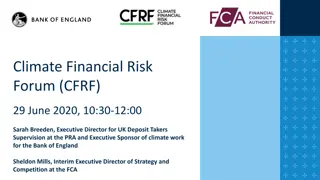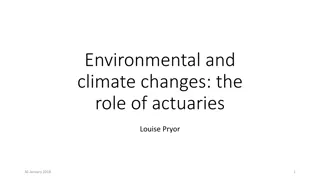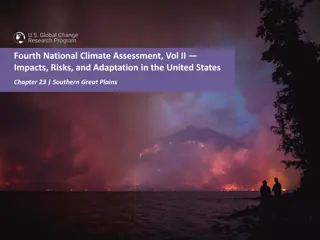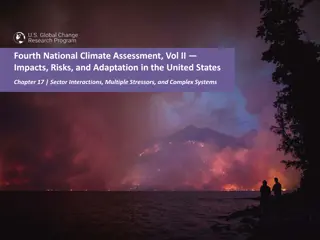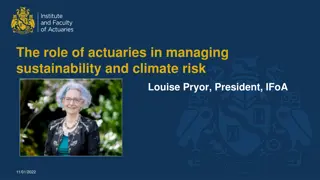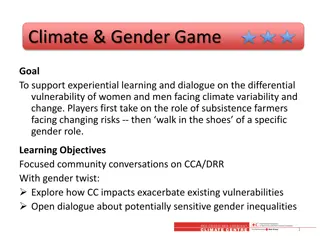Managing Financial Risks in a Changing Climate Environment
Assessing climate-related and environmental risks is vital for ensuring the safety and soundness of financial institutions. These risks include physical risk drivers like extreme weather events and transition risk drivers related to policy measures and technological changes. The complexity and uncertainty of these risks require forward-looking tools such as scenario analysis and stress testing. Addressing these challenges is crucial for maintaining financial stability and resilience in the face of a rapidly evolving climate landscape.
Download Presentation

Please find below an Image/Link to download the presentation.
The content on the website is provided AS IS for your information and personal use only. It may not be sold, licensed, or shared on other websites without obtaining consent from the author.If you encounter any issues during the download, it is possible that the publisher has removed the file from their server.
You are allowed to download the files provided on this website for personal or commercial use, subject to the condition that they are used lawfully. All files are the property of their respective owners.
The content on the website is provided AS IS for your information and personal use only. It may not be sold, licensed, or shared on other websites without obtaining consent from the author.
E N D
Presentation Transcript
Prudential transition plans Brenda Van Tendeloo-NBB FRDO 23/05/2023 Place a footer: Insert > Header & Footer 1
Prudential supervision Goal= ensure safety and soundness of financial institutions and the financial system as a whole Micro-prudential supervision Macro-prudential supervision Minimum capital requirements Pillar 1 Capital buffers ICAAP -Qualitative recommendations -Additional capital add-on SREP Internal Capital Adequacy Assessment Process Pillar 2 Other measures to address systemic risks Supervisory review and evaluation Process (liquidity-based, borrower- based, other) Pillar 3 Disclosure Capital Requirements Regulation (CRR) and 2 Capital Requirements Directive (CRD)
Climate and environmental(C&E)/ESG risks as financial risks Financial contagion (market losses, credit tightening) feeding back to the economy. Economy Financial System Physical risk drivers Extreme weather events Gradual changes in climate Biodiversity loss Direct transmission channels Credit Losses (residential and corporate loans) Business disruption Lower property values Asset Lower corporate asset values destruction Market Losses (Equities, bonds, commodities) Migration Lower household wealth Reconstruction /replacement Transition risk drivers Policy measures Technology Consumer and investor preferences Underwriting losses Lower corporate profitability Stranded assets Operational risk (including reputation risk and litigation) Increased litigation Increase in energy prices Indirect transmission channels Wider economic deterioration (lower demand and output) impacting financial conditions 3 Source: Adapted from NGFS (2019) First Comprehensive report: A call for action. Climate change as source of financial risk.
Assessing climate-related and environmental risks is challenging Physical risks are unprecedented, (tipping points, non-linear) Timing and size of policy actions, technological developments and change in market sentiment are unclear, Past data not a good predictor of future, Uncertainty Beyond usual decision making horizons Short, medium and long term time horizons Time horizon Affect all agents in the economy (households, businesses, governments), across all sectors and geographies Feedback effects Direct and indirect effects Far-reaching impact in breadth and magnitude Need for forward looking tools:Scenario Scenario analysis analysis and and stress stress testing testing (micro + macro) + (micro + macro) + Transition Transition plans plans 4
Climate-related and environmental risks in prudential framework banks EBA: Large banks with listed securities: Implementation gradually as of 2023 (end 2022 position) CRR3: extend to other banks Further think about indicators capturing transition risk reduction through financing emission reductions rather than merely reducing financed emissions Qualitative information + quantitative metrics on physical and transition risks + mitigation actions (e.g Green Asset ratio) Pillar 3 BCBS: working on pillar 3 framework Inclusion in SREP: - Discuss with financial institutions plans to step up risk management in line with supervisory expectations - capital add-on if material shortcomings Include ESG in - business models and strategy - governance and risk appetite - risk management Stress Pillar 2 testing/scenario analysis Take climate/ESG risk into account in current framework Potentially change pillar 1 framework Pillar 1 + Potential macro-prudential measures + transition plans 5
Disclosure-focused, non-prudential transition plans Various voluntary disclosure oriented transition plan frameworks: -GFANZ (Glasgow Financial Alliance for net Net Zero) -TCFD (Taskforce on Climate-related Financial Disclosures) -ISSB (International Sustainability Standards Board) -European Sustainability Reporting Standards of EFRAG (European Financial Reporting Advisory Group) -Transition Plan Taskforce (UK) Non-prudential transition plans Focus on efforts /actions/strategy to -contribute to and prepare for economy-wide transition/ compatibility with climate and other sustainability policy objectives (EU eg climate neutrality by 2050) 6
Prudential vs non-prudential transition plans Transition plans will become mandatory through various EU legislative initiatives, such as CSRD (Corporate Sustainable Reporting Directive), CSDDD (Corporate Sustainable Due Diligence Directive) and CRD6 (Capital Requirements Directive), although not always referred to as such: Legal initiative Scope (credit institutions) Disclosure of plans? CSRD (Final) +ESRS (European Sustainability reporting standards) Listed companies Supervision? All large companies meeting at least 2 out 3 criteria: > 250 employees and/or > 40M Turnover and/or > 20M Total Assets Yes if available, management report Designated NCAs, usually it is the financial conduct authority No Designated NCAs CSDDD (Proposal- trilogue discussions) *EU corporates (incl. financial institutions) with: -more than 500 employees and -net turnover of EUR 150 million OR -more than 250 employees and -net turnover of EUR 40 million of which >50% in high-impact sectors *third-country institutions that generated a net turnover of more than EUR 150 million in the EU, OR EUR 40 million in the EU and >50% worldwide turnover generated in high-impact sector In general all credit institutions Non-Prudential No CRD6 (Proposal- trilogue discussions) SI: SSM LSI: NCAs Prudential 7
Prudential vs non-prudential transition plans Prudential transition plans Non-prudential transition plans Focus on risks to the safety and soundness of the financial institution Focus on contribution to and prepare for economy- wide transition/ compatibility with climate and other sustainability policy objectives (EU eg climate neutrality by 2050) CSRD double materiality Financial materiality Impact materiality Focus banking supervision 8
Prudential transition plans CRDVI proposal on transition plans o Monitor and address risks resulting from misaligment with policy objectives (EU COM) o Monitor and address risks from ESG factors, including from transition trends towards relevant legal and regulatory objectives (EU Council) = Would be significant change in banking supervisors mandates OR NOT? o Ensure adherence to Union s ambition to climate neutrality by 2050 (EU Parliament) Continued non-green lending without considering clients transition plans is no longer compatible with sound risk management Contribution to transition = mitigating future risk CRD VI proposal (art 87a): -supervisors to assess and monitor institutions ESG risk management practices, including transition plans + the progress and the risks to adapt their business models to relevant policy objectives - mandates the EBA to set out the minimum requirements for transitions plans + expectations for supervision. (art 104): -supervisors can require institutions to reduce risks from misalignment with policy objectives and transition trends, including adjustments business model, governance strategies and risk management Can supervisors require contribution to transition/adherence to climate neutrality by 2050? Transition plans are expected to be used as a micro prudential risk management tool. Key tool to extend the time horizon of the supervisory review and to facilitate the assessment by the supervisor of climate/ESG risks Trilogue discussions +discussions with supervisory authorities still going on. In any case alignment prudential and non-prudential transition plans= necessary 9
Prudential transition plans-some preliminary supervisory thoughts Thinking is still developing on how transition plans could support supervisory objectives + what should be included Ensure institutions proactively reflect on technological, business and behavioural changes driven by the sustainable transition and consequences of climate change + demonstrate resilience to these changes Comprehensively identify, measure, assess and embed forward-looking ESG-risks considerations in their strategies and risk management process Includes mitigation + adaptation actions for transition and physical risk, not limited to climate mitigating actions Set and monitor targets and milestones over a long time horizon, at regular time intervals. Need for short, medium and long term targets Prudential transition plans should be aligned with risk strategies, risk appetite statements, business plan, risk management framework and public communication, including CSRD disclosures. GOAL is NOT to force institutions to exit or divest from carbon intensive sectors (or regions/sectors vulnerable to physical risk), But RATHER Financing carbon reductions = essential to driving real economy transition Consistency with pillar 3 disclosures: Pillar 3 + other CSRD/ESRS disclosures= backward-looking-same metrics could be included in transition plans as forward-looking targets: monitor going forward 10
Prudential transition plans-some preliminary supervisory thoughts Credibility of transition plans, avoid greenwashing o Standardise features of plan: scientifically aligned, measurable and verifiable deliverables, o Prudential supervisors may not have appropriate resources/ skills to adequately assess sector/region specific transition plans o Third party verification Counterparty transition plans are necessary for financial institutions to o Assess their risk exposure to C&E/ESG risks o Set and monitor their own transition plans o Be able to adequately contribute to financing the transition (finance emission reductions) At least with large counterparties, institutions should discuss possible options to mitigate risks + steer them towards a trajectory that is aligned with the institution s envisaged portfolio pathway. Cooperation (supervisory authorities, private initiatives) is necessary to leverage skillsets + ensure consistency and interoperability across different regulatory requirements o EBA working on supervisory expectations as mandated by CRD6 o BCBS dedicated subworkstream working on transtion plans,, GFANZ joined April meeting working group on climate risk12 June industry outreach event on transition planning o ECB published opinions on CRD6/CRR3 + ESRS (incl transition plans), transition plans included in work plan for 2023-2024 o NGFS did stocktake, publication following 11









